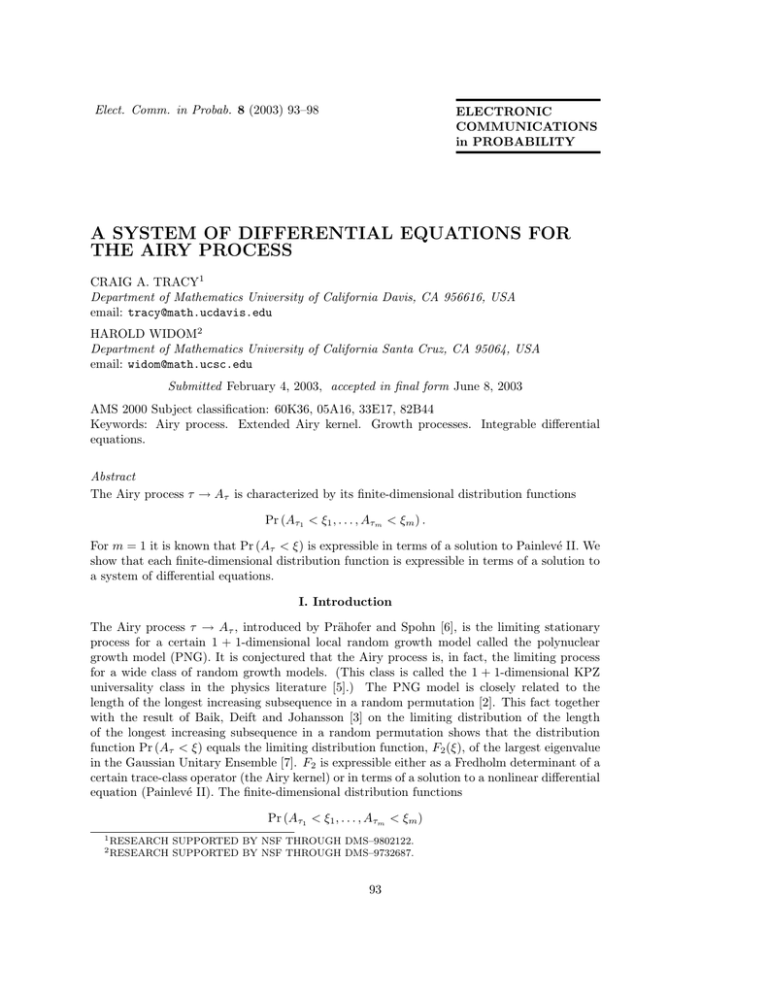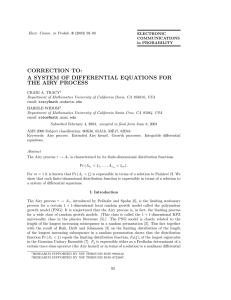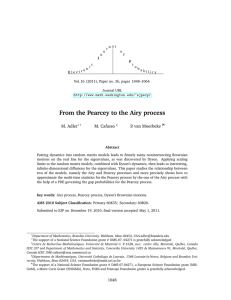A SYSTEM OF DIFFERENTIAL EQUATIONS FOR THE AIRY PROCESS
advertisement

Elect. Comm. in Probab. 8 (2003) 93–98 ELECTRONIC COMMUNICATIONS in PROBABILITY A SYSTEM OF DIFFERENTIAL EQUATIONS FOR THE AIRY PROCESS CRAIG A. TRACY1 Department of Mathematics University of California Davis, CA 956616, USA email: tracy@math.ucdavis.edu HAROLD WIDOM2 Department of Mathematics University of California Santa Cruz, CA 95064, USA email: widom@math.ucsc.edu Submitted February 4, 2003, accepted in final form June 8, 2003 AMS 2000 Subject classification: 60K36, 05A16, 33E17, 82B44 Keywords: Airy process. Extended Airy kernel. Growth processes. Integrable differential equations. Abstract The Airy process τ → Aτ is characterized by its finite-dimensional distribution functions Pr (Aτ1 < ξ1 , . . . , Aτm < ξm ) . For m = 1 it is known that Pr (Aτ < ξ) is expressible in terms of a solution to Painlevé II. We show that each finite-dimensional distribution function is expressible in terms of a solution to a system of differential equations. I. Introduction The Airy process τ → Aτ , introduced by Prähofer and Spohn [6], is the limiting stationary process for a certain 1 + 1-dimensional local random growth model called the polynuclear growth model (PNG). It is conjectured that the Airy process is, in fact, the limiting process for a wide class of random growth models. (This class is called the 1 + 1-dimensional KPZ universality class in the physics literature [5].) The PNG model is closely related to the length of the longest increasing subsequence in a random permutation [2]. This fact together with the result of Baik, Deift and Johansson [3] on the limiting distribution of the length of the longest increasing subsequence in a random permutation shows that the distribution function Pr (Aτ < ξ) equals the limiting distribution function, F2 (ξ), of the largest eigenvalue in the Gaussian Unitary Ensemble [7]. F2 is expressible either as a Fredholm determinant of a certain trace-class operator (the Airy kernel) or in terms of a solution to a nonlinear differential equation (Painlevé II). The finite-dimensional distribution functions Pr (Aτ1 < ξ1 , . . . , Aτm < ξm ) 1 RESEARCH 2 RESEARCH SUPPORTED BY NSF THROUGH DMS–9802122. SUPPORTED BY NSF THROUGH DMS–9732687. 93 94 Electronic Communications in Probability are expressible as a Fredholm determinant of a trace-class operator (the extended Airy kernel) [4, 6]. It is natural to conjecture [4, 6] that these distribution functions are also expressible in terms of a solution to a system of differential equations. It is this last conjecture which we prove. II. Statement The Airy process is characterized by the probabilities ³ ´ Pr Aτ1 < ξ1 , . . . , Aτm < ξm = det (I − K), where K is the operator with m × m matrix kernel having entries Kij (x, y) = Lij (x, y) χ(ξj ,∞) (y) and Lij (x, y) = Z ∞ e−z (τi −τj ) Ai(x + z) Ai(y + z) dz 0 Z − if i ≥ j, 0 e−z (τi −τj ) Ai(x + z) Ai(y + z) dz if i < j. −∞ We assume throughout that τ1 < · · · < τm , and think of K as acting on the m-fold direct sum of L2 (α, ∞) where α < min ξj . To state the result we let R = K (I − K)−1 and let A(x) denote the m × m diagonal matrix diag (Ai(x)) and χ(x) the diagonal matrix diag (χj (x)), where χj = χ(ξj ,∞) . Then we define the matrix functions Q(x) and Q̃(x) by Q = (I − K)−1 A, Q̃ = A χ (I − K)−1 (where for Q̃ the operators act on the right). These and R(x, y) are functions of the ξj as well as x and y. We define the matrix functions q, q̃ and r of the ξj only by qij = Qij (ξi ), q̃ij = Q̃ij (ξj ), rij = Rij (ξi , ξj ).3 Finally we let τ denote the diagonal P matrix diag (τj ). Our differential operator is D = j ∂j , where ∂j = ∂/∂ξj , and the system of equations is D2 q = ξ q + 2 q q̃ q − 2 [τ, r] q, (1) D2 q̃ Dr = q̃ ξ + 2 q̃ q q̃ − 2 q̃ [τ, r], = −q q̃ + [τ, r]. (2) (3) Here the brackets denote commutator and ξ denotes the diagonal matrix diag (ξ j ). This can be interpreted as a system of ordinary differential equations if we replace the variables ξ1 , . . . , ξm by ξ1 + ξ, . . . , ξm + ξ, where ξ1 , . . . , ξm are fixed and ξ variable. Then D = d/dξ, and the ξj are regarded as parameters. To get a representation for det (I − K) observe that ∂j K = −L δj , 3 We α. (4) always interpret Rij (x, ξj ) as the limit Rij (x, ξj +). These quantities are independent of our choice of Differential Equations for the Airy Process 95 where the last factor denotes multiplication by the diagonal matrix with all entries zero except for the j th , which equals δ(x − ξj ). We deduce that ∂j log det(I − K) = −Tr (I − K)−1 ∂j K = Rjj (ξj , ξj ). Hence D log det(I − K) = Tr r, and so it follows from (3) that D2 log det(I − K) = −Tr q q̃ since the trace of [τ, r] equals zero. This gives the representation ½ Z ∞ ¾ det(I − K) = exp − η Tr q(ξ + η) q̃(ξ + η) dη . 0 Here the determinant is evaluated at (ξ1 , . . . , ξm ) and in the integral ξ + η is shorthand for (ξ1 + η, . . . , ξm + η). If m = 1 the commutators drop out, q = q̃, equations (1) and (2) are Painlevé II and these are the previously known results. Note Added in Proof: After the submission of this manuscript, Adler and van Moerbeke [1] found a PDE involving different quantitites than ours for the case m = 2. III. Proof The proof will follow along the lines of the derivation in [7] for the case m = 1. There the kernel was “integrable” in the sense that its commutator with M , the operator of multiplication by x, was of finite rank. The same was then true of the resolvent kernel, which was useful. But now our kernel is not integrable, so there will necessarily be some differences. With D = d/dx we compute that [D, K]ij = −Ai(x) Ai(y) χj (y) + Lij (x, ξj ) δ(y − ξj ) + (τi − τj ) Kij (x, y). Equivalently, [D, K] = −A(x) A(y) χ(y) + L δ + [τ, K], P where δ = j δj , multiplication by the matrix diag (δ(x − ξj )), and L is the operator with kernel Lij (x, y). (For clarity we sometimes write the kernel of an operator in place of the operator itself.) To obtain [D, R] we replace K by K − I in the commutators and left- and right-multiply by ρ = (I − K)−1 . The result is [D, R] = −Q(x) Q̃(y) + R δ ρ + [τ, ρ].4 (5) We have already defined the matrix functions Q and Q̃ and we define Z −1 0 P = (I − K) A , u = (Q̃, Ai) = Q̃(x) Ai(x) dx. It follows from (5) and the fact that τ and A commute that Q0 = P − Q u + R δ Q + [τ, Q].5 4 Because (6) of the fact ρ L χ = R and our interpretation of Rij (x, ξj ) as Rij (x, ξj +) we are able to write R δ ρ in place of ρ L δ ρ. 5 The meaning of δ here and later is this: If U and V are matrix functions then U δ V is the matrix with P P i, j entry U (ξ ) Vkj (ξk ). Thus R δ Q is the matrix function with i, j entry R (x, ξk ) Qkj (ξk ). This k ik k k ik makes it compatible with our use of δ also as a multiplication operator so that, for example, (R δ ρ) (A) = R δ (ρ A). 96 Electronic Communications in Probability Next, it follows from (4) that ∂j R = −R δj ρ, (7) and it follows from this that ∂j Q = −R δj Q. Summing over j, adding to (6) and evaluating at ξk give D Q(ξk ) = P (ξk ) − Q(ξk ) u + [τ, Q(ξk )]. If we define pij = Pij (ξi ) then we obtain D q = p − q u + [τ, q]. (8) Next we use the facts that D 2 − M commutes with L and that M commutes with χ. It follows that [D2 − M, K] = [D 2 − M, L χ] = L [D 2 − M, χ] = L [D 2 , χ] = L (δ D + D δ). It follows from this that [D2 − M, ρ] = ρ L δ D ρ + ρ L D δ ρ. Applying both sides to A and using the fact that (D 2 − M )A = 0 we obtain Q00 (x) − x Q(x) = ρ L δ Q0 + ρ L D δ Q. (9) The first term on the right equals R δ Q0 . For the second term observe that ρ L D χ = ρ L χ D + ρ L [D, χ] = R D + ρ L δ, so we can interpret that term as −Ry δ Q (the subscript denotes partial derivative) where −Ry (x, y) is interpreted as not containing the delta-function summand which arises from the jumps of R. With this interpretation of Ry we can write the second term on the right as −Ry δ Q. Thus, Q00 (x) − x Q(x) = R δ Q0 − Ry δ Q. Using this we obtain from (6) P 0 = x Q(x) + R δ Q0 − Ry δ Q + Q0 u − Rx δ Q − [τ, Q0 ], and then from (6) once more P 0 = x Q(x) + R δ (P − Q u + R δ Q + [τ, Q]) − Ry δ Q +(P − Q u + R δ Q + [τ, Q]) u − Rx δ Q − [τ, P − Q u + R δ Q + [τ, Q] ]. It follows from (5) that Rx + Ry = −Q(x) Q̃(y) + R δ R + [τ, ρ]. (We replaced R δ ρ by R δ R since, recall, Ry does not contain delta-function summands.) We use this and also the identity Rδ[τ, Q] − [τ, RδQ] = −[τ, Rδ]Q, and the fact that δ and τ commute. The result is that Differential Equations for the Airy Process 97 P 0 = x Q(x) + R δ P + Q(x) Q̃δQ + (P − Q u + [τ, Q]) u −2[τ, R] δ Q − [τ, P − Q u + [τ, Q] ]. It follows from (7) that ∂j P = −R δj P . Summing over j, adding to the above and evaluating at ξk give D P (ξk ) = ξk Q(ξk ) + Q(ξk ) Q̃δQ + (P (ξk ) − Q(ξk ) u + [τ, Q(ξk )]) u −2 [τ, R(ξk , · )] δ Q − [τ, P (ξk ) − Q(ξk ) u + [τ, Q(ξk )] ]. Hence D p is equal to ξ q + q q̃ q + (p − q u + [τ, q]) u − 2 [τ, r] q − [τ, p − q u + [τ, q] ]. Equivalently, in view of (8), D p = ξ q + q q̃ q + D q · u − 2 [τ, r] q − [τ, D q]. (10) Let us compute D u. We have uij = Z Z and so Ai(x) χi (x) ρij (x, y) Ai(y) dx dy, Z ∂k uij = −δik Ai(ξk ) ρkj (ξk , y) Ai(y) dy Z Z − Ai(x) χi (x) [Rik (x, ξk ) ρkj (ξk , y)] Ai(y) dx dy, where we use (7) again. This is equal to and so ´ ³ −δik Ai(ξk ) Qkj (ξk ) − Q̃ik (ξk ) − δik Ai(ξk ) Qkj (ξk ), ∂k uij = −Q̃ik (ξk ) Qkj (ξk ). (11) D u = −q̃ q. (12) This gives Next, we find from (7) and (5) that D R(ξj , ξk ) = −Q(ξj ) Q̃(ξk ) + [τ, R(ξj , ξk )]. This gives D r = −q q̃ + [τ, r], which is equation (3). To get equation (1) we apply D to (8) and use (10) and (12). We find that D2 q = ξ q + q q̃ q + D q · u − 2 [τ, r] q − [τ, D q] − D q · u + q q̃ q + [τ, D q] = ξ q + 2 q q̃ q − 2 [τ, r] q, which is (1). Finally, to get equation (2) we use the fact that χj (y) ρjk (y, x) is equal to χk (x) times ρ0kj (x, y), where ρ0 is the resolvent kernel for the matrix kernel with i, j entry Lji (x, y) χj (y). Hence Q̃jk (x) is equal to χk (x) times the Qkj (x) associated with Lji . Consequently for all the differentiation formulas we have for the Qkj (ξk ), etc., there are analogous formulas for the Q̃jk (ξk ), etc.. The difference is that we have to reverse subscripts and replace r by r t and τ by −τ . The upshot is that, by computations analogous to those used to derive (1), we derive another equation which can be obtained from (1) by making the replacements q → q̃ t , q̃ → q t , r → rt , τ → −τ and then taking transposes. The result is equation (2). 98 Electronic Communications in Probability References [1] M. Adler and P. van Moerbeke, A PDE for the joint distributions of the Airy process, preprint, arXiv: math.PR/0302329. [2] D. Aldous and P. Diaconis, Longest increasing subsequences: from patience sorting to the Baik-Deift-Johansson theorem, Bull. Amer. Math. Soc. 36 (1999), 413–432. [3] J. Baik, P. Deift and K. Johansson, On the distribution of the length of the longest increasing subsequence in a random permutation, J. Amer. Math. Soc. 12 (1999), 1119– 1178. [4] K. Johansson, Discrete polynuclear growth and determinantal processes, preprint, arXiv: math.PR/0206208. [5] M. Kardar, G. Parisi and Y. Z. Zhang, Dynamic scaling of growing interfaces, Phys. Rev. Letts. 56 (1986), 889–892. [6] M. Prähofer and H. Spohn, Scale invariance of the PNG droplet and the Airy process, J. Stat. Phys. 108 (2002), 1071–1106. [7] C. A. Tracy and H. Widom, Level-spacing distributions and the Airy kernel, Comm. Math. Phys. 159 (1994), 151–174.









